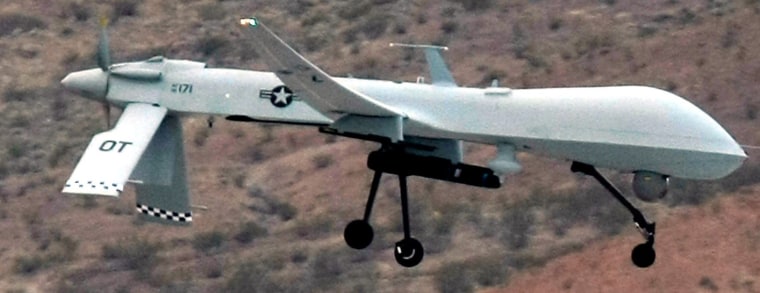Criticism is mounting over Washington's refusal to say anything about missile strikes against Taliban and al-Qaida fighters in Pakistan's northwest, prompting even supporters to argue the U.S. needs to be more open to counter militant allegations that only innocent civilians are dying.
Missiles launched by unmanned drones are the most effective way for the U.S. to go after militants hiding in the lawless border area near Afghanistan because the Pakistani government refuses to allow U.S. troops on its soil and has been reluctant to target many of the fighters itself.
While the government criticizes the strikes as an infringement on national sovereignty, it is widely assumed to privately support the attacks and help provide intelligence.
But the militants are the only ones speaking publicly about people killed in the strikes. Their claims of hundreds of civilian fatalities have made the attacks deeply unpopular in Pakistan, even though they have eliminated hard-line leaders responsible for the deaths of thousands of Pakistanis.
A poll conducted by Gallup Pakistan for Al-Jazeera in July last year found that only 9 percent of Pakistanis supported the drone strikes. The poll was based on face-to-face interviews with more than 2,500 Pakistanis throughout the country and had a margin of error of plus or minus 2 to 3 percentage points.
'A moral mistake'
More information about the CIA-run program could help offset opposition in Pakistan and also assuage concerns that the strikes violate international law.
"The U.S. government doesn't even suggest what the proportion of innocent people to legitimate targets is," said Michael Walzer, an American scholar on the ethics of warfare. "It's a moral mistake, but it's a PR mistake as well."
Several groups in the U.S. have attempted to calculate what percentage of the more than 700 people killed in the drone strikes in Pakistan has been civilians. Without input from Washington, the results have been all over the map, ranging from 98 percent to 10 percent.

Residents interviewed by The Associated Press in Pakistan's North Waziristan tribal area, the site of a majority of the strikes since the program began in 2004, said they believe almost all of the victims are innocent civilians — although it is possible their comments are influenced by fear of the Taliban.
"I have yet to know a terrorist killed in these drone attacks," said Safirullah Khan, a 32 year-old teacher in Mir Ali town. "If someone knows of any, they should tell me and let the world know also."
U.S. officials argue privately that civilian deaths are much lower than are often reported in the press — a tactic that critics say does little to counter the Taliban's claims.
The U.S. silence, which supporters say is driven by operational concerns and the politically sensitive nature of the strikes for Pakistan, has raised questions about whether the program conforms with international law principles governing who can be targeted and what level of collateral damage can be justified.
"I think the main concern for those of us looking at it from the outside is we don't know what the criteria are for the individual decision of whether to pull the trigger or not," said Paul Pillar, a former senior counterterrorism official at the CIA. "Each particular decision is essentially rendering a death sentence on someone and usually more than one someone when you get into the collateral damage."
'Suspicions'
Several different groups, including the U.N. and the American Civil Liberties Union, have pressed the U.S. to reveal who it is killing in the strikes but have so far been rebuffed.
The U.S. government refuses even to acknowledge the drone program in Pakistan, but intelligence officials occasionally leak the names of high-profile militants killed in the strikes, including Pakistani Taliban leader Baitullah Mehsud.
"The CIA may indeed operate as a matter of principle in secrecy, but it cannot legitimately carve itself out as the sole actor which is not subject to any form of accountability when its activities are so well-known and proclaimed with such pride," said Philip Alston, a U.N. investigator of extrajudicial killings.
Concerns about how the CIA picks targets escalated this month following a wave of strikes after a deadly suicide bombing in Afghanistan's Khost province on Dec. 30 killed seven agency employees. Militants in Pakistan are believed to have helped orchestrate the attack.
"As you get the sort of attacks we have seen over the past few days in response to the Khost killings, suspicions start to rise that the standards are dropping and there is a greater willingness to countenance civilian deaths. Some sort of information would be essential to try to provide reassurance," Alston said.
Roger Cressey, a former counterterrorism official in the Clinton and Bush administrations involved in the initial phases of the drone program, believes concerns about its moral basis are overblown.
"The CIA is not going off like a bunch of trigger happy joystick controllers killing people randomly," he said. "They take a very serious and methodical approach to acting upon intelligence and making the decision."
A former U.S. intelligence official said the CIA requires at least two kinds of intelligence to confirm a target before striking — for instance, imagery from the aircraft combined with a radio intercept.
The former official said that even with confirmation, sometimes the CIA will not carry out a strike if there are indications that civilians are at risk. The official spoke on condition of anonymity because they were not authorized to talk publicly about the classified program.
Despite Cressey's confidence in the program, even he is worried about the fact that Washington's silence allows the Taliban to dominate local perceptions about the strikes.
"Nature abhors a vacuum, and if that vacuum is filled by what the Taliban says happens in the drone strikes, then that does influence and impact the population, a population that is incredibly critical to us for our overall success," he said.
